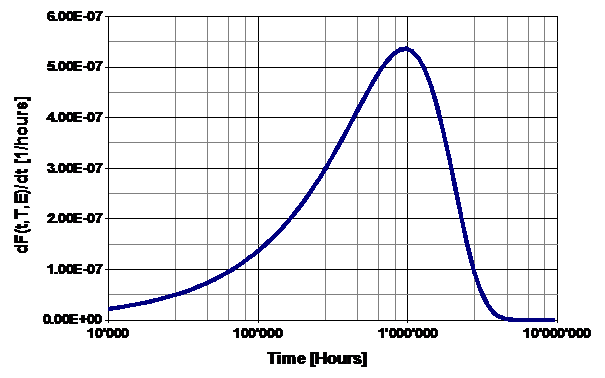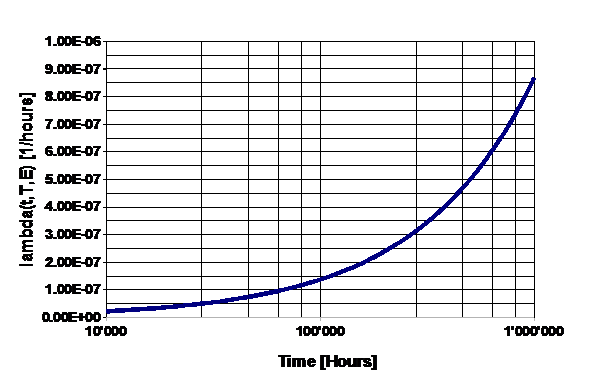
|
|
back
MENU
|
|
Private
|

Reliability
Reliability, Safety, Security definitions
Reliability: ability of an entity to perform under NORMAL conditions
Safety: ability of an entity to perform under ABNORMAL conditions
Security(ability of an entity to perform in the presence of MALEVOLENT environment)
Reliability Prediction: A reliability prediction is simply the analysis of parts and components in an effort to predict and calculate the rate at which an item will fail. A reliability prediction is one of the most common forms of reliability analyses for calculating failure rate and MTBF.
Failure definition
Failure is defined as the lack of ability of a component, equipment, sub system, or system to perform its intended function as designed. Failure may be the result of one or many faults.
Applied to the supercapacitors,the failures may be :
- Capacitance loss greater than 20%
- Series resistance increase bigger than 100%
- Leakage
- Cell opening
There are 2 basic types of failures, Early Failures and Wear Out Failures. These are reflected in the curve known as the Bathtub curve.

Manufacturers test the components at the end of the production process to eliminate "Early Failures" cases. The presentation below concerns the statistical behavior of the components considering the "Wear Out" failures.
Supercapacitor failures
Early Failures
- Leakage
- Short (Rp)
- Welding (Rs)
Failures in operation
- Mechanical rupture due to vibration
- Overpressure due to excessive voltage
- Capacitance loss due to excessive voltage and/or temperature
- Series resistance increase
Survivor function F(t)
This is the number of elements of the statistical sample which have not failed at time t. In other words, it is the number of elements which have not broken down and are still working

Probability density function f(t)
This is the number of failures dF occuring at time t during a unit time period dt in the sample considered.

Failure rate λ(t)
As noted the failure is an event which corresponds to an object breakdown. It is equal to the inverse of the MTBF (Mean Time Between Failure). The failure rate increases with the aging time. λ(t) isn't the number of failures observed in a unit of time; but the ratio of the failures and the number of survivors (or number of breakdowns observed for 1000 elements for example).

Different survivor models
- Exponential model
- Weibull model
- Log-normal model
Exponential model
The simplest statistic model is the particular case of the exponential model.
Probability density function

Survivor function

Failure rate

Mean Time Between Failures (MTBF)

Weibull model
The Weibull model is widely used in electrotechnics.
Probability density function

Survivor function

Failure rate

Mean Time Between Failures (MTBF)

If p is set to 1, it comes out that the exponential model is a particular case of the Weibull model
Log-normal model
The logarithmic mean time

The standard deviation

Probability density function

Survivor function

Units
The failure rate may be expressed with different type of units:

Weibull survivor curve


The survivor function corresponds to the proportion of capacitors in the batch which didn t failed after the time t. It may also be considered as the remaining capacitance of a capacitor after a time t.
Weibull survivor curve


Log(Log(1/(1-F(t))))
Probability density function f(t)
This is the number of failures dF occuring at time t during a unit time period dt in the sample considered.

Failure rate λ(t)
As noted the failure is an event which corresponds to an object breakdown. It is equal to the inverse of the MTBF (Mean Time Between Failure). The failure rate increases with the aging time. λ(t) isn t the number of failures observed in a unit of time; but the ratio of the failures and the number of survivors (or number of breakdowns observed for 1000 elements for example).


The failure rate is given in FIT (Failure In Time ) which is the number of failures occurring during 109 hours of working of an object. λ(t) and &lambda o must not be confused. This latter is a constant (from the time, but is depending on the temperature and on the voltage) which corresponds to the inverse of the time necessary for 63 % of the sample to fail.
Weibull failure rate

The failure rate value given in the manufacturer specifications, as it is increasing with time, corresponds to the value for the end of life.
Failure modes
The ultracapacitor failure modes are:
Cell opening due to the electrochemical decomposition overpressure.
The voltage and the temperature generate a gas pressure inside the cell which slowly increases with the time. When the pressure reaches a certain limit, a mechanical fuse, generally a groove on the can, open softly.
Or 20% capacitance loss
The carbon accessible surface and the ions availability are reduced during the solicitation
-
Or 100% ESR increase
The electrode adhesion on the collector is alterated with time and temperature. The ions availability is reduced.